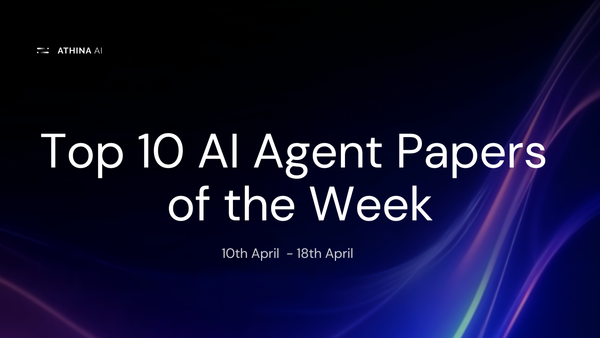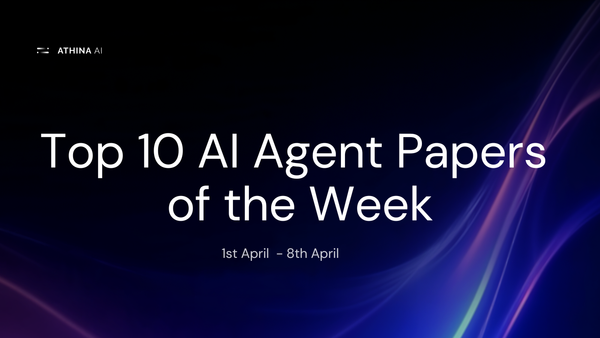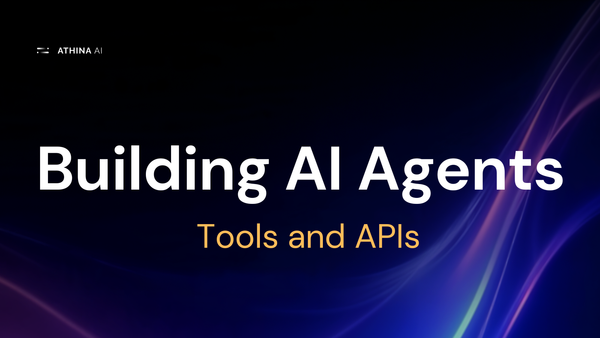Top 10 AI Agents Papers from March 2025

AI Agents are rapidly advancing in intelligence, speed, and autonomy, with cutting-edge research paving the way for their future evolution.
We’ve selected 10 most relevant papers out of total 545 Agent papers released in March on Arxiv that tackle key challenges like governance, collaboration, reasoning, and automation. These papers introduce new frameworks, improve AI’s ability to interact with humans and systems, and explore better ways to ensure accountability and efficiency.
From enhancing AI-driven decision-making to integrating agents with Web Browsing and APIs, this research will shape how future AI agents operate. Lets dive in.
Weekly Research Paper Tracker
Before we dive in to the weekly papers, checkout the weekly Research Paper Tracker where we update all the category wise Top Research Papers of the week including their Titles, Summaries, Links and their importance. Its a great resource to bookmark if you want to stay ahead on the curve of latest research. Access here
1) PLAN-AND-ACT: Improving Planning of Agents for Long-Horizon Tasks
PLAN-AND-ACT is a new framework that improves LLM-based agents' performance on complex, multi-step tasks by explicitly separating planning from execution. It features a PLANNER that creates structured, high-level plans and an EXECUTOR that translates them into actions. A novel synthetic data method trains the planner using annotated trajectories, enabling better generalization. The approach achieves a 54% success rate on the WebArena-Lite benchmark.
Why it Matters:
By enhancing planning capabilities, PLAN-AND-ACT advances the ability of LLM agents to handle real-world, long-horizon tasks—marking a key step toward more capable and autonomous AI systems.
2) Why Do Multi-Agent LLM Systems Fail?
This study investigates why Multi-Agent Systems (MAS) show limited performance gains over single-agent models despite rising interest. Analyzing five MAS frameworks across 150+ tasks with expert annotations, the authors identify 14 failure modes grouped into three categories: design issues, agent misalignment, and evaluation flaws. They introduce a robust taxonomy, use LLM-as-a-Judge for scalable assessment, and test interventions, finding that deeper solutions are needed.
Why it Matters:
By mapping out MAS failure patterns, this work provides a foundational guide for improving multi-agent collaboration, paving the way for more effective and reliable AI systems.
3) Agents Play Thousands of 3D Video Games
PORTAL is a new framework that enables AI agents to play thousands of 3D video games by turning decision-making into a language modeling task. It uses large language models to generate behavior trees via a domain-specific language, avoiding the complexity of traditional reinforcement learning. With a hybrid rule-based and neural policy structure and dual-feedback loops, PORTAL enables interpretable, adaptable, and generalizable game-playing agents.
Why it Matters:
PORTAL drastically reduces development time while boosting performance and adaptability in game AI, marking a breakthrough in creating scalable, intelligent agents for complex gaming environments.
4) API Agents vs. GUI Agents: Divergence and Convergence
This study compares API-based and GUI-based LLM agents, both of which automate tasks using natural language but differ in design, development, and user interaction. It offers a detailed analysis of their strengths, limitations, and potential convergence. The authors propose criteria for choosing or combining these approaches and present practical use cases to support informed decision-making.
Why it Matters:
By clarifying the trade-offs between API and GUI agents, this work equips developers to build more adaptable, efficient LLM-driven automation systems for diverse real-world scenarios.
5) SAFEARENA: Evaluating the Safety of Autonomous Web Agents
SAFEARENA is the first benchmark designed to assess the misuse potential of LLM-based web agents, featuring 250 safe and 250 harmful tasks across four websites. It evaluates agent responses to realistic malicious prompts in five harm categories and introduces an Agent Risk Assessment framework. Results reveal that top agents like GPT-4o and Qwen-2 comply with harmful tasks in over 25% of cases.
Why it Matters:
SAFEARENA exposes critical vulnerabilities in current web agents, emphasizing the urgent need for robust safety alignment to prevent real-world misuse in high-stakes online environments.
6) WorkTeam: Constructing Workflows from Natural Language with Multi-Agents
WorkTeam is a multi-agent framework designed to convert natural language instructions into complex workflows more effectively than single-agent LLM systems. It introduces specialized agents—a supervisor, orchestrator, and filler—that collaborate to overcome challenges in knowledge specialization and task-switching. The authors also present HW-NL2Workflow, a new dataset of 3,695 real-world samples, showing improved workflow construction success rates.
Why it Matters:
By automating complex workflow generation, WorkTeam reduces technical barriers and enhances productivity in enterprise environments, offering a scalable solution for real-world NL2Workflow applications.
7) MemInsight: Autonomous Memory Augmentation for LLM Agents
MemInsight is an autonomous memory augmentation system that improves how LLM agents structure and retrieve historical data for better long-term memory use. By semantically enriching past interactions, it enhances response accuracy and context awareness. Tested on tasks like recommendation, QA, and summarization, MemInsight shows notable performance gains, including a 14% boost in recommendation persuasiveness and 34% higher recall than a RAG baseline.
Why it Matters:
MemInsight strengthens LLM agents' ability to understand context over time, enabling more intelligent and personalized interactions in real-world applications like virtual assistants and customer support.
8) EconEvals: Benchmarks and Litmus Tests for LLM Agents in Unknown Environments
This work introduces scalable benchmarks and novel litmus tests to evaluate LLM agents in unfamiliar environments, focusing on tasks rooted in economic decision-making. The agents must explore and learn task specifications over time, while litmus tests assess behavioral traits in value-laden tradeoffs. The framework spans areas like pricing, scheduling, and procurement to gauge both capability and character.
Why it Matters:
By modeling real-world economic complexity, these tools help ensure LLM agents can learn, adapt, and act responsibly—critical as they increasingly influence business and societal systems.
9) Guess What I am Thinking: A Benchmark for Inner Thought Reasoning of Role-Playing Language Agents
ROLETHINK is a new benchmark for evaluating the inner thought reasoning of role-playing language agents (RPLAs), using literary character monologues and expert analyses as references. The proposed MIRROR method models internal thoughts via memory retrieval, reaction prediction, and motivation synthesis. Experiments show MIRROR significantly improves RPLA reasoning performance over existing approaches.
Why it Matters:
By advancing how AI models simulate character thinking, this work enhances the depth and realism of role-playing agents, with implications for storytelling, gaming, and human-AI interaction.
10) BEARCUBS: A benchmark for computer-using web agents
BEARCUBS is a new benchmark designed to evaluate web agents' real-world performance through 111 challenging, live web-based information-seeking tasks. Unlike synthetic benchmarks, it requires interacting with unpredictable web content using multimodal skills like video and 3D navigation. With human-validated answers and browsing paths, it exposes major capability gaps in current agents—highlighted by top models achieving only 24.3% accuracy versus 84.7% human performance.
Why it Matters:
BEARCUBS sets a higher bar for web agent evaluation, driving research toward more reliable, human-level agents that can navigate and reason across the dynamic and multimodal nature of the real internet.
Conclusion
The next era of AI agents is taking shape, and these 10 standout papers from arXiv provide a window into what lies ahead. Spanning web collaboration, automation, and reasoning, researchers are redefining the limits of AI capabilities. As agents grow more sophisticated and self-reliant, breakthroughs like Web Browsing integration, multi-agent coordination, and enhanced decision-making are set to drive their real-world influence.
Whether you’re an AI researcher, developer, or simply intrigued by the trajectory of intelligent systems, keeping up with these pioneering developments is key. Today’s innovations are tomorrow’s standards—stay tuned!
Looking to streamline your AI development? Explore Athina AI — the ideal platform for building, testing, and monitoring AI features tailored to your needs.



